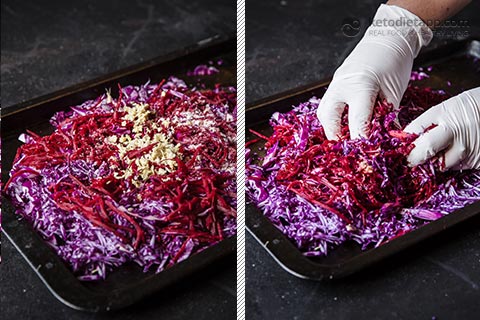Follow us 148.4k
I’ve been trying to get more fermented foods into my daily diet. I brew my own kombucha and love that, but I’d really like to branch out into different types of fermentation.
Sauerkraut is a brilliant beginners ferment and the addition of grated beetroot in this one gives it such a pretty, jewel-like colour that you just want to pop a spoonful on your plate. Remember, as with any fermented food, start with a small amount and build it up gradually.
How many carbs does Sauerkraut have?
Sauerkraut is made by lacto-fermentation. The bacteria present in the cabbage convert sugars into lactic acid, thus decreasing the overall carb content. This process is also present in full-fat yogurt, another keto-friendly food. That's why the carb content in "real" yogurt is often lower than labeled (the actual net carbs go down by 30-70%)! The problem is that most commercially available yogurts don't ferment long enough and the carbs content only decreases by about 30%.
It's not possible to know the exact carb count in this recipe, so nutrition facts are estimated from regular sauerkraut with the addition of beetroot.
Note: The rule of thumb here is one tablespoon of salt per every three pounds of vegetables, which equates to 1.360 grams. Our vegetables are about a third of this amount, so between 1 and 2 teaspoons of salt will fit the calculation. I don’t like my sauerkraut too salty, so I erred on the lower side. More salt makes for a more likely successful result though, so be guided by your own instincts.
Hands-on Overall
Serving size 1/4 cup/ 35 g/ 1.2 oz
Nutritional values (per 1/4 cup/ 35 g/ 1.2 oz)
Net carbs0.8 grams
Protein0.4 grams
Fat0.1 grams
Calories8 kcal
Calories from carbs 63%, protein 28%, fat 9%
Total carbs1.8 gramsFiber1 gramsSugars0.9 gramsSaturated fat0 gramsSodium194 mg(8% RDA)Magnesium5 mg(1% RDA)Potassium69 mg(3% EMR)
Ingredients (makes 1 medium jar/ 3 1/2 cups)
- 450 grams red cabbage, grated (1 lb)
- 1 small beetroot (85 g/ 3 oz)
- 1 tsp sea salt or pink Himalayan salt (see note)
- 1 tsp grated fresh ginger
Instructions
- Cut the cabbage in quarters and remove the hard core. Discard any dry outer leaves.

- Using a mandolin, or a sharp knife if you’re super clever, finely slice the red cabbage.
- Peel and grate the raw beetroot (I use food handling gloves from this point to avoid staining my hands).

- Grate the ginger until you have one teaspoon and then sprinkle the salt over the mixture.
- Mix and squeeze all the ingredients well.

- Start placing the mixture into a clean glass jar, pounding it down well as you go. I use the rounded handle of a mixing spoon, but anything will work as long as it mashes the cabbage mix down. You want to start releasing the juices from the vegetables.

- Continue packing and compressing until the jar is full and the juices are to the top. If there are not enough juices to cover your mix, place the jar aside for eight hours and give it another press.

- Cover the mouth of your jar with a cloth and secure with an elastic band. Keep your jar somewhere that is a stable temperature, not too cold and not too hot.
- After a week, start tasting your ferment until you are happy with the way it tastes. This is a personal thing, so I can only say that you will know when you’re happy.

- Cover the jar and place in the fridge. This will slow the fermentation down. Store in a jar in the refrigerator for up to two months. Use your Pink Sauerkraut as an addition to your dishes, or as a garnish.

Ingredients
- 450 grams red cabbage, grated (1 lb)
- 1 small beetroot (85 g/ 3 oz)
- 1 tsp sea salt or pink Himalayan salt (see note)
- 1 tsp grated fresh ginger
Instructions
- Cut the cabbage in quarters and remove the hard core. Discard any dry outer leaves.
- Using a mandolin, or a sharp knife if you’re super clever, finely slice the red cabbage.
- Peel and grate the raw beetroot (I use food handling gloves from this point to avoid staining my hands).
- Grate the ginger until you have one teaspoon and then sprinkle the salt over the mixture.
- Mix and squeeze all the ingredients well.
- Start placing the mixture into a clean glass jar, pounding it down well as you go. I use the rounded handle of a mixing spoon, but anything will work as long as it mashes the cabbage mix down. You want to start releasing the juices from the vegetables.
- Continue packing and compressing until the jar is full and the juices are to the top. If there are not enough juices to cover your mix, place the jar aside for eight hours and give it another press.
- Cover the mouth of your jar with a cloth and secure with an elastic band. Keep your jar somewhere that is a stable temperature, not too cold and not too hot.
- After a week, start tasting your ferment until you are happy with the way it tastes. This is a personal thing, so I can only say that you will know when you’re happy.
- Cover the jar and place in the fridge. This will slow the fermentation down. Store in a jar in the refrigerator for up to two months. Use your Pink Sauerkraut as an addition to your dishes, or as a garnish.
Nutrition (per 1/4 cup/ 35 g/ 1.2 oz)
Calories8kcal
Net Carbs0.8g
Carbohydrates1.8g
Protein0.4g
Fat0.1g
Saturated Fat0g
Fiber1g
Sugar0.9g
Sodium194mg
Magnesium5mg
Potassium69mg
Detailed nutritional breakdown (per 1/4 cup/ 35 g/ 1.2 oz)
Do you like this recipe? Share it with your friends!